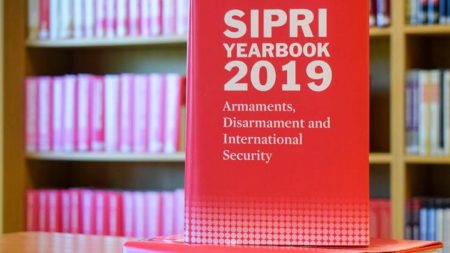Stockholm International Peace Research Institute (SIPRI) 20/06/2019 – Posted in: Daily News
STOCKHOLM INTERNATIONAL PEACE RESEARCH INSTITUTE (SIPRI)- 2019 YEARBOOK
For: Mains
Topics covered: SIPRI report on Nuclear weapons, 50th Yearbook of SIPRI
News Flash
The Stockholm International Peace Research Institute (SIPRI) launches the findings of SIPRI Yearbook 2019, which assesses the current state of armaments, disarmament and international security.
Findings
- A report by a SIPRI, the think-tank has found that the worldwide total of nuclear warheads has decreased since 2018 but countries are modernizing their nuclear arsenals.
- It is found that nine nuclear-armed countries (including India) had a total of some 13,865 nuclear weapons at the start of 2019, which is a decrease of 600 nuclear weapons from 14,465 at the start of 2018.
- Of these 13,865 nuclear weapons, 3,750 are deployed with operational forces and nearly 2,000 of these are kept in a state of high operational alert.
Why the decrease in nuclear weapons?
- The decrease in the overall number of nuclear weapons in the world is due mainly to Russia and the USA— which together still account for over 90 percent of all nuclear weapons.
- They both also reduce their strategic nuclear forces pursuant to the implementation of the 2010 Treaty on Measures for the Further Reduction and Limitation of Strategic Offensive Arms (New START) while also making unilateral reductions.
- In 2018, Russia and the USA announced that they had achieved the final New START (Strategic Arms Reduction Treaty) force reduction limits by the specified deadline.
- New START will expire in 2021 unless both parties agree to extend it.
- Both Russia and the US have extensive and expensive programmes underway to replace and modernize their nuclear warheads, missile and aircraft delivery systems, and nuclear weapon production facilities.
Strategic Arms Reduction Treaty (START)
START was a bilateral treaty between the United States of America and the Union of Soviet Socialist Republics on the reduction and limitation of strategic offensive arms. The treaty was signed on 31 July 1991 and entered into force on 5 December 1994.
What’s next?
- The nuclear arsenals of the other nuclear-armed states are considerably smaller, but all are either developing or deploying new weapon systems or have announced their intention to do so.
- China, India and Pakistan are increasing the size of their nuclear arsenals.
- India and Pakistan are expanding their military fissile material production capabilities.
- North Korea continues to prioritize its military nuclear programme as a central element of its national security strategy.
SIPRI Yearbook 2019
The 2019 edition is the 50th Yearbook that SIPRI has produced.
SIPRI Yearbook 2019 provides analysis on armed conflict and peace processes, nuclear disarmament, arms control (conventional and nuclear) and non-proliferation—including key developments in Russian–US nuclear arms control, Iran and the Joint Comprehensive Plan of Action, and the Treaty on the Prohibition of Nuclear Weapons.
SIPRI
SIPRI is an independent international institute dedicated to research into conflict, armaments, arms control and disarmament. Established in 1966, SIPRI provides data, analysis and recommendations, based on open sources, to policymakers, researchers, media and the interested public. Based in Stockholm, SIPRI is regularly ranked among the most respected think tanks worldwide.
SIPRI’s mission is to
- undertake research and activities on security, conflict and peace;
- provide policy analysis and recommendations;
- facilitate dialogue and build capacities;
- promote transparency and accountability; and
- deliver authoritative information to global audiences.
Source: SIPRI
You can follow us on LinkedIn and for more updates related to UPSC IAS Preparation, Like our Facebook Page and subscribe our Diligent IAS Youtube Channel
Also, Read Related Daily News
- One Nation, One Election
- India’s GDP Growth
- Anti-Anthrax Vaccine
- Government’s objectives for “New India”
- Factoids: India’s First Water Clinic for Elephants


